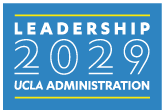Management Topic: Strategic Talent Planning Part 1: Analyzing the Department’s Needs
Dear Colleagues,
We previously discussed the importance of strategic talent planning to sustain an organization’s health and growth and to foster excellence. This month, we will continue this discussion and explore considerations in assessing the needs of the workforce, as well as the department. Providing career progression opportunities for current staff supports employee retention and furthers Administration’s goal to build and engage a high-performing workforce.
Strategic Talent Planning at UCLA
Departments interested in beginning a strategic talent planning process should work with their human resources business partner, equity advisor, and CHR’s Learning & Organizational Development team to:
- Obtain data to assess current state and define future state goals.
- Set goals for workforce strategic planning.
- Identify employee skills and experience necessary for leadership and institutional success.
- Dedicate time for self-assessments and talent development conversations.
- Establish and publicize objective criteria for participation in talent development programs and communicate expectations.
- Develop talent pools rather than “heir-apparent” successors.
Key components of the planning process include “succession planning” (identifying talent vacancy risks and creating retention and development plans) and “talent review” (identifying, planning, and acting on talent needs). These components include an assessment phase where leadership identifies anticipated business challenges over the next five years; critical positions needed to address these challenges; and competencies, skills, and institutional knowledge needed for the future. Leadership will also need to identify key management positions, including positions with high turnover, those that take the longest to fill, and require upskilling or reskilling based on current workforce trends, and obtain data supporting the above. Additional useful metrics include: total number of staff participating in development programs, applicant diversity, and the number of internally qualified applicants.
In the evaluation phase, leadership will need to consider “high-potential” employees in key roles as well as the competencies, skills, and knowledge that are needed for all staff to be successful. Discussions with individual employees regarding their interest in upward or lateral movement in their careers is essential in this process to ensure those interested in career movement will be prepared when opportunities arise. The questions below from the management consulting company Gartner can be utilized to assist in these discussions:
Most Compelling Strength
- What are 1-2 strengths that really set this individual apart from others?
- How could these be best leveraged in the organization?
- How to further develop these strengths?
Most Significant Development Area
- What are 1-2 development areas that are most important for this individual to address to be able/ready to move into more senior jobs?
- What actions are being taken to address these development needs?
Overall Performance Over Time
- Based on what you have learned/observed about this individual during the years they have worked at this current level, why are you rating them as a Contributing/Meets/Exceptional in terms of their overall performance?
- What have you seen or not seen?
- Where are they trending?
This process will allow the department to begin to formulate a thorough talent management plan. Please note that the emphasis of strategic talent planning is on ensuring a qualified pool of applicants is available should a vacancy arise, not an “heir-apparent”.
Resources and Considerations
- The UC Quick Start Guide outlines three steps to begin to implement a talent and succession management program.
- Systemwide Human Resources has licensed a Talent and Succession Planning Toolkit by author Doris Spies. Your human resources business partner, equity advisor, and CHR’s Learning & Organizational Development team can assist you through your Strategic Planning Process and best advise you in using the various tools available in this toolkit.
- Be mindful not to allow implicit bias to creep into this process. The UC Managing Implicit Bias Series is a series of six eCourses designed to increase awareness of implicit bias and reduce its impact. These courses can be taken as helpful refreshers as you begin your strategic talent planning process.
- To assist departments in this planning process, best practices for staff development will be covered in next month’s MMT!
- It’s important to note that as a federal contractor, the University must take into consideration the Department of Labor requirements to allow for open and competitive recruitments. However, departments may request Internal Recruitments, where a job is posted internally for UC Systemwide or UCLA recruitment. Internal recruitment may be appropriate where there is a sufficiently qualified and diverse pool of candidates.
To learn more about this topic, please contact: Talent Acquisition Manager Michael Yates at myates@chr.ucla.edu regarding the recruitment process and Lead Manager, L&OD Rejeana Mathis at rmathis@chr.ucla.edu for staff and management development guidance.

Interested in reviewing prior months’ topics? Visit our Monthly Management Tips website.
Do you have feedback, questions or a suggested topic you would like to learn more about? Please email: managementtips@ucla.edu.
Want to receive Monthly Management Tips emails? Sign up for our list!

